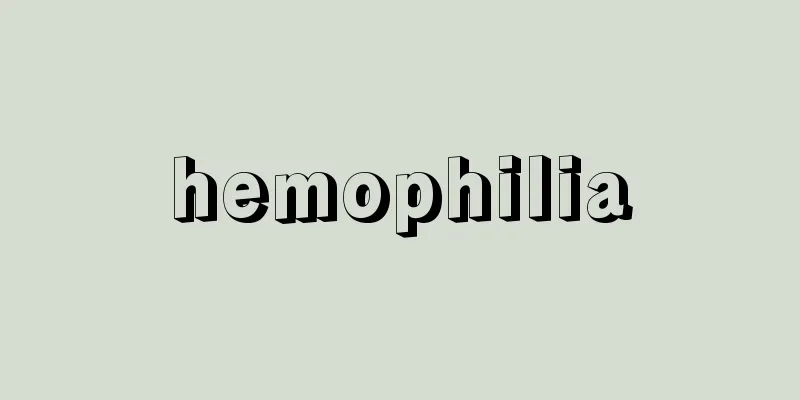hemophilia

|
Definition and Concept Hemophilia is an X-linked recessive bleeding disorder characterized by recurrent bleeding from childhood, mainly intra-articular bleeding. Hemophilia A is characterized by quantitative and qualitative abnormalities in factor VIII (FVIII), while hemophilia B is characterized by abnormalities in factor IX (FIX). Heterozygous females are carriers. The incidence rate is 1 in 5,000 to 10,000 males. Pathophysiology: Factor X activation by activated factor IX (FⅨa) is an essential rate-limiting reaction in the blood coagulation mechanism. Activated factor VIII (FⅧa) amplifies the Vmax of this reaction system by 200,000 times. Therefore, a decrease in FⅧ or FⅨ ultimately leads to impaired thrombin production, resulting in a serious tendency to hemorrhage. Genetic abnormalities in hemophilia A include point mutations (nonsense, missense), inversions, deletions, and splicing abnormalities. Among these, intron 22 inversion is the most characteristic genetic abnormality of hemophilia A, and is detected in approximately 40% of severe cases. Inversions, deletions, and nonsense mutations do not produce FⅧ, and are called null mutations, which are factors in the development of inhibitors, as described below. Unlike hemophilia A, more than 90% of genetic abnormalities in hemophilia B are point mutations. Clinical manifestations 1) Subcutaneous bleeding: It presents as a purpura the size of a fingertip to a coin (occasionally larger), and often forms a subcutaneous hematoma that can be palpated as bruising. 2) Joint bleeding: Bleeding occurs most frequently in the knee, foot, and elbow joints, in that order, but it can also occur in any joint, such as the shoulder or hip. After symptoms such as joint discomfort and fatigue, the joint becomes swollen, accompanied by severe pain, heat, and redness. The range of motion of the affected joint is restricted. Repeated intra-articular bleeding causes progressive degeneration and inflammation of the synovial membrane, increasing the frequency of bleeding, and the joint becomes known as a target joint. As arthropathy progresses, the joint space narrows due to a decrease in articular cartilage. Furthermore, the bone destruction process can lead to bone sclerosis, cyst formation, and osteophytes, resulting in severe impaired joint movement. 3) Muscle bleeding: It is likely to occur in the muscles of the lower limbs, such as the gastrocnemius, soleus, thigh, gluteal, and iliopsoas muscles, as well as in the flexor muscles of the forearm. It often appears after trauma, strenuous exercise, or intramuscular injections, but the cause may not be clear. Severe pain and swelling result in impaired movement of the affected area. Iliopsoas bleeding causes the patient to be in the psoas position, with the hip joint flexed. Intramuscular bleeding can compress blood vessels and nerves, causing compartment syndrome. Furthermore, if intramuscular bleeding under the periosteum progresses gradually, a cyst containing necrotic tissue and blood clots due to bleeding can form, causing the progressive destruction of the surrounding tissue. This is called a pseudotumor. 4) Hematuria: Hematuria is frequent in patients with severe disease. Bleeding originates from the glomerulus or renal tubules. It is generally accompanied by symptoms such as discomfort or pain in the lower back. It often recurs. It may become protracted. 5) Oral bleeding: It can occur on the gums, upper labial frenulum, lingual frenulum, lips, and tongue due to minor cuts or bites. Hematomas often form. Daily prevention of caries and periodontal disease is necessary. 6) Severe bleeding symptoms: a) Intracranial hemorrhage: This is the most common cause of death from hemorrhage. It may be due to minor trauma or spontaneous hemorrhage of unknown cause. Clinical symptoms include headache, vomiting, convulsions, confusion, visual impairment such as double vision, and coma. In severe cases with head trauma, replacement therapy is recommended for all patients. Usually, replacement therapy alone can be used to treat the patient, but if an image shows a clear focus of hemorrhage, surgical treatment should be considered and a neurosurgery department should be consulted early. b) Intraperitoneal hemorrhage: Intraperitoneal hemorrhage can occur even with a minor abdominal bruise. It progresses slowly, but the patient often presents with severe anemia. When subcutaneous bleeding is observed in the abdomen, intraperitoneal hemorrhage should always be considered. Hemorrhage into the intestinal wall is also common. c) Cervical hemorrhage: Cervical hemorrhage can cause suffocation and is a very dangerous type of hemorrhage with a high mortality rate. First, replacement therapy should be administered and an otolaryngologist should be consulted to determine the extent of the hemorrhage and the degree of airway compression symptoms. Test results: The activated partial thromboplastin time (aPTT), which reflects the intrinsic pathway, is prolonged, but the prothrombin time (PT), which reflects the extrinsic pathway, is normal. A definitive diagnosis is made by finding a deficiency or decrease in factor VIII or factor IX. von Willebrand factor levels are normal to elevated. Bleeding symptoms in hemophilia correlate well with the coagulation activity of factor VIII or factor IX. Activity of less than 1% is classified as severe, 1-5% as moderate, and >5% as mild. Differential diagnosis includes von Willebrand disease with decreased factor VIII, hemophilia A carriers, combined factor VIII and factor V deficiency, and acquired factor VIII inhibitors (Table 14-12-1). The factor VIII or factor IX in the complicated preparation may be recognized as non-self, causing the development of anti-factor VIII or anti-factor IX alloantibodies (inhibitors). When inhibitors are developed, the subsequent hemostatic effect is drastically reduced or eliminated. Inhibitors are measured by the Bethesda method, which is based on a one-stage coagulation method. Patients with high inhibitor titers (BU, Bethesda unit) (>5 BU/mL) are called high responders (HR), and those with low inhibitor titers (<5 BU/mL) are called low responders (LR). In the case of HR, administration of replacement therapy preparations causes an anamnetic reaction in which inhibitor levels rise sharply 5 to 7 days after administration. Treatment 1) Treatment of patients without inhibitors: a) Hemostatic therapy: Replacement therapy using plasma-derived or recombinant preparations is the basis (Table 14-12-1). The dosage of the preparation varies depending on the site of bleeding and the severity of the bleeding symptoms (Table 14-12-2) (Matsushita et al., 2008). Preparations are usually administered intravenously intermittently (as a bolus), but continuous infusion therapy is more effective in cases of severe bleeding or major surgical procedures. b) Prophylactic administration: This is replacement therapy in which a preparation is administered in advance to prevent bleeding. It is divided into on-demand prophylactic administration when the risk of bleeding is high, and regular replacement therapy, which is administered regularly to prevent bleeding over the long term. In general, trough (minimum value) levels can be maintained at >1% by administering 30-40 units/kg 2-3 times a week or every other day. Early regular replacement therapy prevents the onset and progression of hemophilic arthropathy, and therefore the mainstay of hemophilia treatment in the pediatric field is shifting from on-demand hemostatic therapy to regular replacement therapy (Manco-Johnson et al., 2007). 2) Treatment of patients with inhibitors: a) Hemostatic therapy: If an inhibitor is detected, the hemostatic therapy is determined based on the inhibitor titer, responsiveness (HR or LR), and the severity of bleeding symptoms. In cases where the inhibitor is <5 BU/mL and the patient is LR, the first choice is generally to continue replacement therapy. In cases where the patient is HR, bypass hemostatic therapy is the first choice. Two bypass hemostatic therapy preparations are used: activated prothrombin complex concentrate (APCC) and recombinant activated factor VII preparation (rFVIIa) (Figure 14-12-1). Guidelines for hemostatic therapy for inhibitor-positive patients have also been published by the Hemophilia Subcommittee of the Standardization Committee of the Japanese Society on Thrombosis and Hemostasis (Tanaka et al., 2008). b) Immune tolerance induction (ITI): Immune tolerance therapy (ITI) is a treatment in which inhibitor-positive patients are continuously administered coagulation factor preparations in an attempt to eliminate the inhibitor, and is becoming the most important treatment for inhibitor-positive patients. The past peak inhibitor titer and the inhibitor titer at the start of ITI are significant factors for the success of ITI. Internationally, there are high-dose administration methods in which 200 U/kg is administered daily and low-dose administration methods in which 50 U/kg is administered 3 to 3.5 times a week. The high-dose method requires a shorter period to achieve immune tolerance, but the efficacy rate is equivalent to that of the low-dose method (Hay et al., 2012). [Shima Midori] ■ References Hay CRM, DiMichele DM, et al: The principal results of the International Immune Tolerance Study: a randomized dose comparison. Blood, 119: 1335-1344, 2012. Tadashi Matsushita, et al.: Guidelines for coagulation factor replacement therapy in acute bleeding, treatment, and surgery in hemophilia patients without inhibitors. Japanese Journal of Thrombosis and Hemostasis, 19: 510-519, 2008. Manco-Johnson et al: Prophylaxis versus episodic treatment to prevent joint disease in boys with severe hemophilia. N Engl J Med, 357: 535-544, 2007. Ichiro Tanaka et al.: Guidelines for hemostatic treatment for patients with congenital hemophilia and inhibitors. Japanese Journal of Thrombosis and Hemostasis, 19: 520-539, 2008. Hemophilia treatment products "> Table 14-12-1 Guidelines for hemostatic management of hemophilia (Matsushita et al., 2008) Table 14-12-2 Algorithm for selecting therapeutic agents for hemophilia patients with inhibitors "> Figure 14-12-1 Hemophilia (nervous system disorder associated with blood disease)Hemophilia is an X-linked recessive congenital coagulation disorder. There are two types of hemophilia: hemophilia A, in which factor XIII activity is reduced, and hemophilia B, in which factor IX activity is reduced. Point mutations, insertions, and inversions in the causative genes have been identified. The clinical symptoms of hemophilia are bleeding, and neurological complications accompany bleeding. In the central nervous system, intracerebral bleeding is common in infancy and the elderly, and can be the initial symptom. The period from head injury to the onset of symptoms in hemophilia patients is characterized by a longer asymptomatic period than in general patients, except for subdural hematomas, and careful observation of about one week is required. Trauma can also cause bleeding within the spinal cord and within and outside the dura, but bleeding into the spinal cord tissue not only leaves severe damage, but can also be life-threatening, such as respiratory arrest, at the cervical spinal cord level, so immediate medical intervention is required. In the peripheral nervous system, bleeding into the tissues around the peripheral nerves and the formation of a hematoma can cause compartment syndrome, resulting in neurological disorders. Treatment, such as tissue decompression surgery, should be started early while administering replacement therapy. In addition, chronic encapsulated hematomas can cause nerve compression and repeated bleeding can limit the movement of muscles and joints. [Kiyoshi Arimura] Source : Internal Medicine, 10th Edition About Internal Medicine, 10th Edition Information |
|
定義・概念 血友病は幼少期より関節内出血を中心にさまざまな出血症状を反復するX連鎖劣性遺伝性の出血性疾患である.第Ⅷ因子(FⅧ)の量的・質的異常症が血友病A,第Ⅸ因子(FⅨ)の異常症が血友病Bである.ヘテロ接合体である女性は保因者となる.発症率は男性5000~1万人に1人である. 病態生理 活性型第Ⅸ因子(FⅨa)による第Ⅹ因子活性化反応は血液凝固機構における必須の律速反応である.活性型の第Ⅷ因子(FⅧa)は本反応系のVmaxを20万倍増幅する.したがってFⅧやFⅨの低下は結果的にはトロンビン産生障害をきたすために重大な出血傾向をもたらす.血友病Aの遺伝子異常は,点変異(ナンセンス,ミスセンス),逆位,欠失,スプライシング異常などが代表的である.中でもイントロン22の逆位は血友病Aの最も特徴的な遺伝子異常で,重症 型の約4割に検出される.逆位,欠失,ナンセンス変異ではFⅧは産生されず,ヌル変異といわれ,後述するインヒビターの発生要因になる.血友病Bの遺伝子異常は血友病Aと異なり90%以上が点変異である. 臨床症状 1)皮下出血: 指頭大〜貨幣大(ときにはそれ以上)の紫斑を呈し,しばしば,皮下硬結(bruising)として触知される皮下血腫を形成する. 2)関節内出血: 出血頻度は膝,足,肘関節の順に高いが,その他,肩や股関節などいずれの関節にも発症する.関節の違和感や倦怠感などの前兆のあと,激しい疼痛,熱感,発赤を伴う関節の腫脹が出現する.当該関節の可動域は制限される.関節内出血を反復すると,関節滑膜の変性や炎症が進行することにより出血頻度はますます増加し,標的関節(target joint)とよばれる.関節症が進行すると,関節軟骨が減少するために関節裂隙が狭小化する.さらに骨の破壊過程により骨硬化,囊胞形成,骨棘像などがみられるようになり重度の関節運動障害をきたす. 3)筋肉内出血: 腓腹筋やヒラメ筋,大腿筋,臀筋,腸腰筋などの下肢の筋や前腕の屈筋などに発生しやすい.外傷や過激な運動,筋肉注射後に出現することが多いが,原因が明らかでない場合もある.疼痛と腫脹が激しく,当該部位の運動障害をきたす.腸腰筋出血では股関節を屈曲する腸腰筋位(psoas position)を呈する.筋肉内出血は血管や神経を圧迫していわゆるコンパートメント(筋区画)症候群を発症することがある.また,骨膜下の筋肉内出血が漸次進行した場合,出血による壊死組織と凝血塊を内容とする囊胞が形成され,周囲の組織が進行性に破壊されることがある.これは偽腫瘍とよばれる. 4)血尿: 血尿は重症型患者で頻度が高い.出血は糸球体あるいは尿細管由来である.一般に,腰部の違和感や疼痛などの前兆を伴うことが多い.しばしば再発する.遷延化することもある. 5)口腔内出血: 軽微な切傷や咬傷によって歯肉,上口唇小帯,舌小帯,口唇および舌に発生する.しばしば血腫を形成する.日常の齲歯および歯周病の予防が必要である. 6)重篤な出血症状: a)頭蓋内出血:出血死の原因としては最も多い.軽微の外傷や原因不明の自然出血の場合もある.臨床症状は頭痛,嘔吐,痙攣,混迷,復視などの視力障害,昏睡などである.重症例で頭部外傷のあった場合には全例に補充療法の実施がすすめられる.通常,補充療法のみで治療できる場合が多いが,画像で明らかな出血巣が認められた場合には,外科治療も考慮して,早期に脳神経外科にコンサルトする. b)腹腔内出血:腹腔内出血は腹部の軽微な打撲でも発生することがある.進展は緩徐であるが,しばしば重症な貧血を呈する.腹部に皮下出血をみたときは常に腹腔内出血を留意する必要がある.腸管壁内出血もよくみられる. c)頸部出血:頸部出血は窒息をきたすことがあり,致命率の高い非常に危険な出血である.まず,補充療法を行い,耳鼻咽喉科にもコンサルトし,出血巣の範囲,気道圧迫症状の程度を判断することが必要である. 検査成績 内因系を反映する活性化部分トロンボプラスチン時間(aPTT)が延長するが,外因系を反映するプロトロンビン時間(prothrombin time:PT)は正常である.確定診断は第Ⅷ因子あるいは第Ⅸ因子の欠乏~低下所見による.von Willebrand因子は正常~上昇する.血友病の出血症状は第Ⅷ因子あるいは第Ⅸ因子の凝固活性によく相関する.活性が1%未満を重症,1~5%が中等症,>5%を軽症と分類される. 鑑別診断 第Ⅷ因子低下を伴うvon Willebrand病,血友病A保因者,第Ⅷ因子第Ⅴ因子合併欠乏症,後天性第Ⅷ因子インヒビターなどが鑑別の対象となる(表14-12-1). 合併症 製剤中の第Ⅷ因子あるいは第Ⅸ因子を非自己と認識して抗第Ⅷ因子あるいは抗第Ⅸ因子同種抗体(インヒビター)が発生することがある.インヒビターが発生すると以後の止血効果は激減~消失する.インヒビターは凝固1段法に基づくBethesda法により測定される.インヒビター力価(BU,Bethesda unit)が高値の場合(>5 BU/mL)をハイレスポンダー(high responder:HR),低値の場合(<5 BU/mL)をローレスポンダー(low responder:LR)とよぶ.HRの場合,補充療法製剤を投与すると投与5~7日後にインヒビターが急上昇する既応反応(アナムネスティック)反応をきたす. 治療 1)インヒビター非保有例の治療: a)止血療法:血漿由来製剤あるいは遺伝子組み換え型製剤による補充療法が基本である(表14-12-1).製剤の投与量は出血部位や出血症状の重症度により異なる(表14-12-2)(松下ら,2008).製剤は通常,間欠的(ボーラス)に経静脈的に投与するが,重篤な出血や大きな外科手術の際は持続輸注療法がより効率的である. b)予防的投与:あらかじめ製剤を投与して出血を予防する補充療法である.出血の発現リスクが高い場合にオンデマンドで実施する予防投与と,定期的に投与することにより長期間にわたって出血を予防する定期的補充療法に分けられる.一般に,30~40単位/kg,2~3回/週あるいは隔日に投与することで,トラフ(最低値)を>1%に維持できる.早期定期補充療法は血友病性関節症の発症と進行を防ぐことから,小児科領域では,血友病治療の主体はオンデマンド止血療法から定期補充療法へと移行している(Manco-Johnsonら,2007). 2)インヒビター保有例の治療: a)止血療法:インヒビターが検出された場合,インヒビター力価,反応性(HRかLR),出血症状の重症度により止血療法を決定する.インヒビターが<5 BU/mLでLRの場合は一般的に補充療法の続行が第一選択になる.HRではバイパス止血療法が第一選択になる.バイパス止血療法製剤は活性化プロトロンビン複合体製剤(APCC)と遺伝子組み換え型活性型第Ⅶ因子製剤(rFⅦa)の2剤が使用される(図14-12-1).インヒビター保有例の止血療法に関するガイドラインも日本血栓止血学会標準化委員会血友病部会から発表されている(田中ら,2008). b)免疫寛容療法(immune tolerance induction:ITI):免疫寛容療法(ITI)はインヒビター陽性例に凝固因子製剤の投与を継続してインヒビターの消失をはかる治療法で,インヒビター陽性例の最も重要な治療法になりつつある.過去のピークインヒビター力価とITI開始時のインヒビター力価が低いことが有意のITIの成功因子である.国際的には200 U/kgを連日投与する高用量投与法と50 U/kgを週3~3.5回投与する低用量投与法がある.高用量の方が免疫寛容にいたる期間が短いが,有効率は低用量と同等である(Hayら,2012).[嶋 緑倫] ■文献 Hay CRM, DiMichele DM, et al: The principal results of the International Immune Tolerance Study: a randomized dose comparison. Blood, 119: 1335-1344, 2012. 松下 正,他:インヒビターのない血友病患者の急性出血,処置・手術における凝固因子補充療法のガイドライン.日本血栓止血学会誌,19: 510-519, 2008. Manco-Johnson et al: Prophylaxis versus episodic treatment to prevent joint disease in boys with severe hemophilia. N Engl J Med, 357: 535-544, 2007. 田中一郎,他:インヒビター保有先天性血友病患者に対する止血治療ガイドライン.日本血栓止血学会誌,19: 520-539, 2008. 血友病治療製剤"> 表14-12-1 血友病の止血管理指針(松下ら,2008)"> 表14-12-2 インヒビター保有血友病患者に対する治療製剤選択のアルゴリズム"> 図14-12-1 血友病(血液疾患に伴う神経系障害)血友病はX連鎖劣性遺伝性の先天性凝固障害症で,第ⅩⅢ因子活性が低下する血友病Aと第Ⅸ因子活性が低下する血友病Bがあり,それぞれの原因遺伝子の点変異,挿入,逆位などが明らかになっている.血友病の臨床症状は出血であり,神経合併症も出血に伴うものである.中枢神経系では乳児期や高齢者に脳内出血が多くみられ,かつ初発症状となることがある.血友病患者での頭部受傷から症状発現までの期間は,硬膜下血腫を除く一般の患者に比較して無症状の期間が長いことが特徴であり,1週間程度の慎重な経過観察を要する.外傷による脊髄内および硬膜内外の出血も起こるが,脊髄組織への出血は高度の障害を残すのみならず,頸髄レベルでは呼吸停止などの生命への危険性もあるため早急な治療介入が必要である.末梢神経系では末梢神経周囲組織への出血,血腫形成によるコンパートメント症候群が起こり神経障害をきたす.補充療法を行いながら組織の減圧手術などの治療を早期に開始する.また慢性の被包化された血腫による神経の圧迫や,反復する出血は筋関節の可動制限なども起こる.[有村公良] 出典 内科学 第10版内科学 第10版について 情報 |
Recommend
Stridulating organ
The sound-producing organ of insects consists of a...
Xu Jing
…The original meaning of the word is the first da...
Standard battery - hyojundenchi (English spelling) standard cell
A primary cell that exhibits a highly accurate el...
Achidanthera bicolor (English name)
…[Tora Saburo Kawabata]. … *Some of the terminolo...
Kashima (Ehime) - Kashima
…The Awai district in the southern part of the ci...
symmoria
...Collection of taxes can be confirmed from 428 ...
Earth ellipsoid - Chikyu daentai
The ellipsoid that most closely resembles the sha...
Village Directory - Village Directory
This was a ledger prepared by the Edo Shogunate ma...
Hydrophobic sol (English spelling)
...Hydrosols use water as a dispersion medium, wh...
Educational Affairs Bureau
An administrative agency established as an externa...
Siberian blue robin
A bird of the Turdus subfamily, family Muscicapid...
Oshira Asobase - Oshira Asobase
For the festival, shrine maidens such as Itako, W...
canyon
… escarpment—scarpA long, narrow, relatively stee...
Trinity - Sanshintai (English spelling) Trimūrti [Sanskrit]
A Hindu doctrine that Brahma, Vishnu, and Shiva ar...
Abū'l Ḥasan (English spelling) Abul Hasan
…Landscape painting and bird-and-flower painting ...









